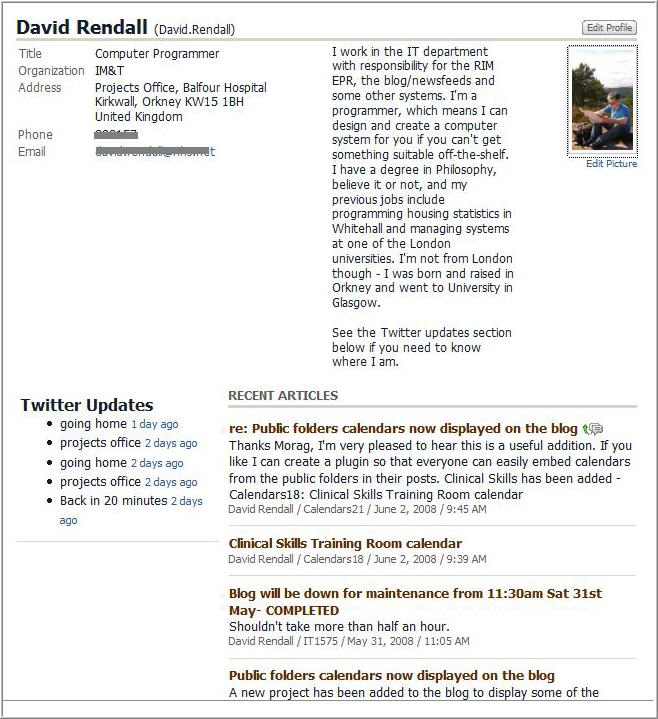NHS integrates Intranet 1.0 with Enterprise 2.0 to get Social with TeamPage 4.0
The UK's National Health Service's Orkney region deployed Traction with great success in 2005 to address an unfavorable report about the state of internal communications. The original NHS Orkney Customer Story details how they used Traction for everything from wiki collaboration on policies and procedures to action tracking and even an internal blog to announce "stuff for sale." Since then, usage has only improved and Traction has also been deployed at the NHS Camden region. In June, David Rendall upgraded to the recently announced TeamPage 4.0 Release. I'm pleased to be able to share some of his notes and screen shots - to offer a glimpse into how an organization facing major Internal Communications deficiencies just three years ago is an Enterprise 2.0 leader today.
Parts of this story were published in eWeek's June 2008 Article Traction Digs in for Enterprise Wiki Control
Bridging Intranet 1.0 with Enterprise 2.0 to get Social
Looking up a phone number or name in a corporate directory is about as natural and frequent as picking up morning coffee. So, NHS figured out how to bridge the digital cultural divide and drive traffic to and interest in their Traction TeamPage deployment by including user friendly corporate directory.
The directory system allows employees to lookup the contact details of any other employee. Here is their directory record for David Rendall:
A simple change to the directory now links to the employee's Traction TeamPage User Profile page:
The User Profile page (by default) includes the individual's contact information and content sections for their recently posted Articles and Comments. The content section shows all the contributions by the author that you (with your permissions) can read. It's like having a blog that can even be navigated with a Calendar, but it's a roll-up of all your contributions to different Traction project spaces.
Rendall says:
My favorite new feature in Traction 4 is the Profile. All our staff can now create their own space on the blog to tell others who they are and what they do. Being able to upload a photo is proving to be very popular - little things like that can inject a bit of fun into the working day which ultimately builds a better workplace community. The profile page also displays all the recent articles which you've worked on, which in turn encourages you to feel stronger ownership of the content you post. It doesn't have to be a list of recent articles though.
Rendall added a picture and a bit of a bio. He merged Comments into his Recent Articles section and added a Section which simply uses an iFrame widget to display his Twitter updates. The integration of the Web based Twitter service with his intranet based Traction TeamPage User Profile brings these technologies together to serve NHS staff needs.
The profile page can be configured to display any specific content you want, including pictures or widgets which display information from other sites. Personally, I list my recent articles in one column and my Twitter updates in the other. I use Twitter as an electronic In/Out board: not very exciting, but very useful for someone trying to get in touch with me.
In this case, his use of Twitter may serve the same need to communicate his status to his friends, as well as internal NHS employees who may need to know what he's doing. As Rendall says, this use of Twitter may not be exciting - but it will be the next time someone knows to find him back in his office in 20 minutes - in order to chase him down for help with a critical problem.
Using Moderation When Openness and Privacy Requirements Collide
NHS Orkney has activated the Page and Comment Moderation features in TeamPage 4.0 in various Traction workspaces. The goal to communicate most information widely remains a priority - but the users don't need to worry so much about the quality and accuracy of intermediate edits. Rendall says:
The new wiki-style moderation feature is also proving useful. Being able to hide an article from the hoi polloi while you work on it is a huge improvement. I use Traction groups to define who can post to a project (publishers). The publishers can see unpublished drafts, but non-publishers and visitors can't. This makes it easier to work collaboratively, and to fine-tune your posts before letting everyone else see them.
The use of moderation may serve two needs. The first case is when beta bloggers simply want to be careful about sharing intermediate edits. The second case is when a certain group or department has door one requirements to only "publish" those versions of wiki pages which have been sanctioned or approved. One case may be a Human Resources Policy Wiki where you would want to avoid the scenario where a reader takes an intermediate edit of a policy to reflect an agreed change to the actual policy currently in place.
Rendall's group was also pleased to see updates to the Linking tool in TeamPage 4.0. He remarks:
The ability to be able to search and browse content on the Traction server - and even link to Views - is an excellent addition. You really have to see the page in action to fully appreciate how good it is.
Rendall says Traction TeamPage is as much an experience as it is a product. Hearing about it is one thing, but diving in and immersing yourself and your organization is required to understand and experience the benefits. When you succeed, a Typical Day's Work isn't about posting one entry and reading five, it's moving your work to your Wiki. Rendall's deployment began in 2005 (see original NHS Orkney Customer Story, written in 2007), and a sure sign of success is that it just keeps getting better and better rather than noisier and messier. Or lonely and abandoned.



 I18N ERROR: @tsiskin#footer_RSS_Feed
I18N ERROR: @tsiskin#footer_RSS_Feed